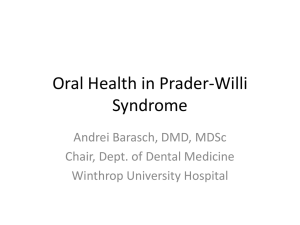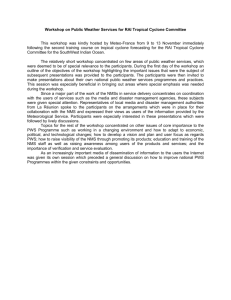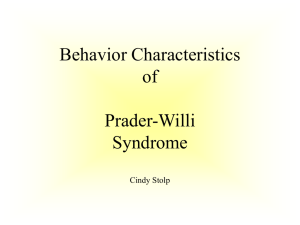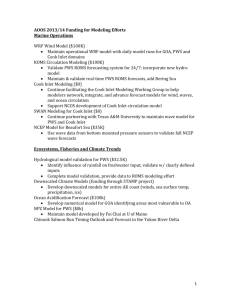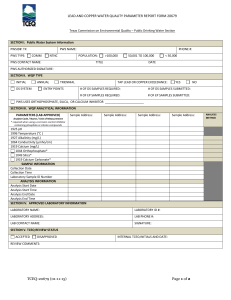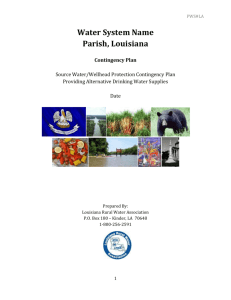Public Weather Services programme
advertisement
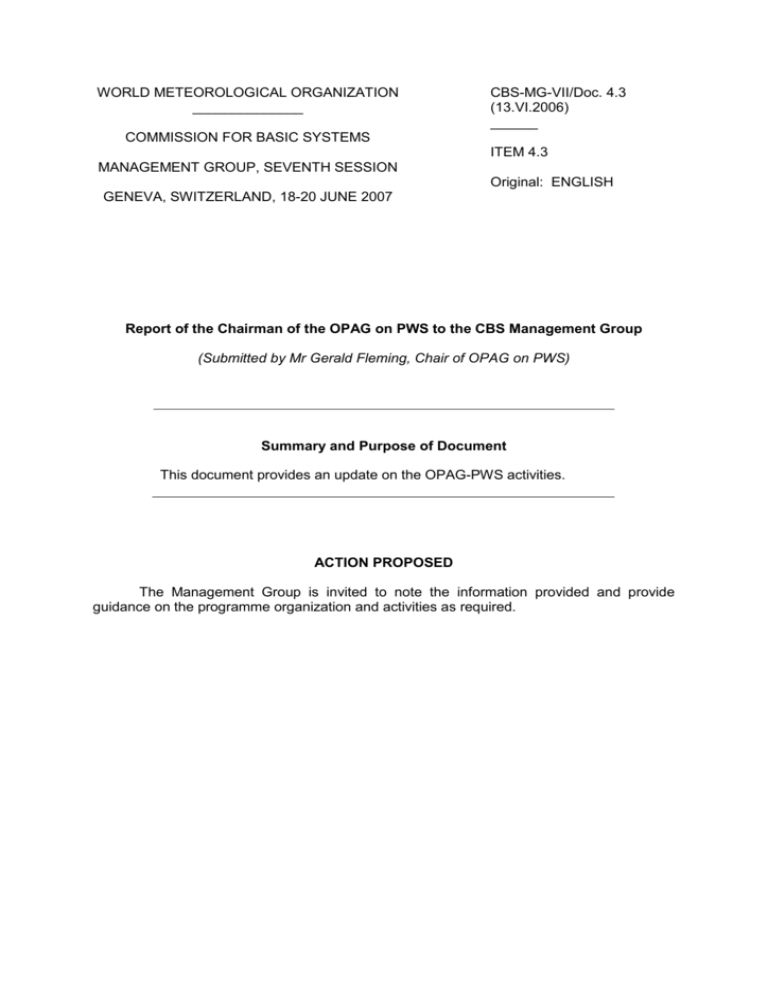
WORLD METEOROLOGICAL ORGANIZATION ______________ CBS-MG-VII/Doc. 4.3 (13.VI.2006) ______ COMMISSION FOR BASIC SYSTEMS ITEM 4.3 MANAGEMENT GROUP, SEVENTH SESSION Original: ENGLISH GENEVA, SWITZERLAND, 18-20 JUNE 2007 Report of the Chairman of the OPAG on PWS to the CBS Management Group (Submitted by Mr Gerald Fleming, Chair of OPAG on PWS) Summary and Purpose of Document This document provides an update on the OPAG-PWS activities. ACTION PROPOSED The Management Group is invited to note the information provided and provide guidance on the programme organization and activities as required. CBS-MG-VII/Doc. 4.3, p. 2 Report of the Chairman of the OPAG on PWS to CBS Management Group 1. The ICT of the OPAG met in Muscat, Sultanate of Oman, from 4 to 9 June 2007. In addition to the Chair and the Co-Chair of the OPAG, the meeting was attended by the Chairs of the three Expert Teams active in the OPAG, together with the PWS Rapporteur for RA VI. 2. An unexpected “guest” at the meeting was Tropical Cyclone GONU which struck Oman on the night of June 5th/6th, and which brought very strong winds and torrential rain to the Muscat region, finally heading north towards Iran on the night of 6-7 June. This was the worst Tropical Cyclone to hit OMAN in 30 years. 3. It was clear that the Meteorological Service of Oman had been very effective in issuing early warnings for this event; they had been engaged in meetings with the civil authorities for some days prior to landfall, and the national TV station was dominated by news of the cyclone’s progress and advice to citizens on June 4th and 5th. Nevertheless, GONU was responsible for (at the time of writing) 61 deaths; 49 in Oman and 12 in Iran, mostly from flooding. The members of the ICT toured some of the affected area on the evening of 7 June, seeing for themselves the devastation caused to the road network, and the damage to property and infrastructure. Review of decisions of Fifteenth WMO Congress (Cg-XV) and the Extraordinary Session of CBS (CBS-Ext.(06)) 4. The meeting reviewed the decisions of both CBS-Ext.(06) and Cg-XV of relevance to the future development and the implementation of the PWS Programme. The meeting was pleased that the PWS Strategy which had been developed at the ICT meeting in Dublin (October 2005) had been approved by both CBS and Congress with minor modifications and that this Strategy would guide the detailed plans of action developed within the PWS Programme. Also approved with some small changes were the core and recommended elements of a national PWS Programme drafted at the Dublin meeting. The new initiatives taken by the PWS Programme with respect to nowcasting, probabilistic forecasting, public education and outreach, and socio-economic applications of PWS had all been welcomed by both CBS and Congress. 5. The ICT discussed the new and emerging issues of special importance to the work of the PWS Programme which would have influence over the structure and direction of the OPAG. These included the WMO Strategic Plan and how it would shape all the WMO Programmes and especially the future of the service delivery functions at all levels of WMO. In addition, discussions resulting from the Madrid Conference on the relationship between users and providers of information and services, and the work of the Task Force on the Socio-economic Applications of Meteorological and Hydrological Services in this area would no doubt have significant influence on the mode of operation of the PWS Programme and the OPAG. 6. Of great relevance was the decision to hold an International Symposium on PWS; this suggestion has come from the Executive Council and had been agreed by both CBS and Congress. This Symposium was tentatively scheduled for the first week in December 2007, in Geneva. 7. The meeting agreed that the demands on the PWS OPAG and Programme were increasing in complexity and scope. It was likely that the areas of Water and Climate would increasingly look to the PWS Programme for support and guidance in matters related to service delivery, giving the Programme a function beyond the traditional area of “Weather”. In discussing these trends, the ICT was of the opinion that terms like “Severe Weather” were becoming less relevant, being replaced by the concept of “High Impact Weather” which CBS-MG-VII/Doc. 4.3, p. 3 implied an understanding of the effect, or impact, of weather on the public and on specialised user communities. The ICT agreed that part of its response to this increase in complexity and scope should be to go “back to basics” in focusing on the key elements of good Public Weather Services – quality in service delivery, effective communication, user focus and user-driven verification. 8. Whilst the emerging vista encompassed both opportunities and threats, the OPAG should adopt a forward looking and anticipatory attitude towards the emerging trends and issues which would have influence on the implementation of the PWS Strategy. It accepted that there did not exist today a clear definition of the boundary between Public Weather Services and Commercial Weather Services, and recognised that this boundary would vary from country to country and from one context to another. Socio-economic Applications of PWS 9. The ICT reviewed the outcomes of the recent WMO Conference on Secure and Sustainable Living, (Madrid, March 2007) and specifically the Madrid Action Plan (MAP), which encompassed the outcomes of the conference and provided a recommended series of actions which would promote the aims of the conference into the future. 10. Noting in particular Action 9 and Action 11 of the MAP, the ICT recognised that these Actions might be progressed through the establishment of a PWS Pilot Project directed at improving service delivery in a small number of NMHSs and assessing the improvement, through increased recognition of the NMHS brand or otherwise. This PWS Pilot Project is discussed in more depth below, under the section “Consideration of the Future Expert Teams Structures and Roles”. 11. The ICT discussed the work of the Task Force on Social and Economic Applications of PWS (TF-SEA). It considered whether the Task Force might be constituted as an Expert Team, and was favourably disposed to the concept, provided that the members of the Task Force were agreeable. It was recognised that this would widen the scope of the work of the OPAG within the CBS structure. The ICT recognised the growing importance of the social and economic aspects of weather services, and noted that the work of the Task Force was aligned with the PWS Strategy as adopted at Cg-XV, in particular addressing point (g). Severe Weather Forecasting Demonstration Project (SWFDP) 12. This project is organised under the OPAG on DPFS; the Chair of ET/SPI participates as a member of the Project Steering Group. The Co-Chair of the OPAG is active within the field phase of the project. 13. Following the field phase of the subproject, a comprehensive evaluation will be performed to assess the degree to which the enhanced severe weather forecasting process of the SWFDP has improved the detection and warning of severe weather events. The Project Steering Group strongly encouraged that the user communities, including the national disaster management and civil protection authorities/agencies, be involved with the evaluation of the national warning service provided by NMHSs during the project. 14. The ICT Co-Chair provided some additional insight into the progress of the SWFDP for South-Eastern Africa, from the perspective of RSMC Pretoria. The project has been successful, and can be used as a benchmark for future projects. Proper planning with defined time frames and commitment from the participating parties have been key to the success of the project. It was noted that significant efforts have to be made to gather feedback from participating countries. Feedback from the disaster management community CBS-MG-VII/Doc. 4.3, p. 4 is welcomed, and it should be maximised as it is viewed as a very important input within the context of OPAG/PWS. 15. A review of the project to-date has identified several gaps or limitations which should be examined for follow up, and taken into account for future related projects. These gaps include: Very limited understanding of nowcast applications in some countries, including limited understanding of NWP limitations; Transmission of data/products is extremely slow and unreliable in some countries; this limits the effectiveness of the use of these products when provided through the Internet; Lack of frequent feedback from NMHSs to RSMC on the usefulness of the guidance when severe weather is occurring, and on the observed weather conditions during the event. 16. The project recognised the importance of working closely with the media, as well as emergency managers, so as to derive the greatest benefit from the improvement in forecast capabilities. It recommended a stronger involvement of these sectors in future activities of the SWFDP. European Initiatives of Relevance to the Work of the OPAG on PWS 17. The RA VI sub-group continues to monitor the Global Monitoring and Environmental Security (GMES) activities taking place within the European Union so that they are, wherever possible, in alignment with PWS activities within Europe. 18. The Chair briefed the ICT on the establishment of the Climate Broadcasters Network – Europe (CBN-E). This was a network of weather broadcasters working in Europe who were active in raising awareness in regard to Climate Change and its impacts. The EU (through its Environment Directorate) will fund secretarial assistance for the network; this secretariat will help prepare and distribute information and materials which members can use in their own countries or regions when making presentations about Climate Change. Consideration of the Future Expert Teams Structures and Roles 19. In reviewing of the future direction which the OPAG should take, the members of the ICT considered that; (a) Much work had been done in the recent past in gathering and setting down, in guideline documents, a considerable body of knowledge related to aspects of public weather services and service delivery; (b) These guideline documents had been widely distributed, and published on the PWS pages of the WMO website, but there was no real measure of the extent to which they had been used, and the knowledge contained within them applied, by Members. (c) The task of ensuring that, in so far as possible, those on the front line of delivering services in NMHSs were aware of, trained in, and putting into practice the advice and guidance which had been collected and published was a difficult challenge for WMO. CBS-MG-VII/Doc. 4.3, p. 5 20. The ICT considered that the OPAG should embark on a PWS Pilot Project whereby a co-ordinated training and mentoring programme might be devised which would focus on a small group of neighbouring countries, and which would draw on the expertise available through the Expert Teams as well as that provided through the Secretariat. The focus of the PWS Pilot Project would be on “Learning Through Doing”; the aim would be to work with the staff of the relevant NMHSs in assisting them to improve their communication with users in a defined range of sectors, and to develop and deliver an improved range of products and services which would enhance the socio-economic benefits provided through the NMHSs to Members. 21. The ICT defined the objectives and scope of the PWS Pilot Project, developed a timeline for implementation, and set out actions (and related milestones) which would need to be undertaken. While the focus of the project would, in all likelihood, be in the developing world, the ICT established a number of criteria which a candidate country would need to meet in order to engage with the PWS Pilot Project. 22. The ICT considered that, as the PWS Pilot Project would absorb a considerable degree of time and effort on behalf of experts active within the OPAG, the individual Expert Team deliverables to be agreed at the next CBS session might be streamlined, in order to maintain an acceptable workload for ET members. 23. The PWS Programme had taken the initiative to convene an Expert Group on Public Education and Outreach; this EG had, with the assistance of a consultant retained by WMO, produced an excellent set of Guidelines on the topic, published as PWS-14. While this Expert Group was not intended to have an ongoing existence, the ICT was of the opinion that this work was important to the overall goals of the OPAG, and that it should be taken within the OPAG in so far as possible. Accordingly, ET/COM was asked to take responsibility for ongoing work in these areas. In line with this development of responsibility, it was proposed that ET/COM be re-named the Expert Team on Communication, Outreach and Public Education aspects of PWS; to be known as ET/COPE. 24. All of the Expert Teams within the OPAG had TORs and deliverables related to WWIS and SWIC. The ICT was of the opinion that it would be more efficient to gather these together under one Team, who would assume overall responsibility for all matters relating to the websites within the OPAG. Accordingly, it was agreed that all matters to do with these websites would be responsibility of ET/DPM, with a clear understanding that this ET could draw on the expertise available within other Teams as appropriate. Preparations for CBS-XIV (2008) 25. The TORs of all the constituent Expert Teams within the OPAG have been reviewed, together with the TORs of the ICT. Adjustments were made to the TORs to reflect the completion of some tasks, and to reflect the decisions made at the meeting of the ICT. These amended TORs are, as yet, in early draft form; the Chairs of the Expert Teams will discuss them at the meetings of the ETs, scheduled for 2008, and may propose further changes. Members of the ICT will then agree on the final draft of TORs to be proposed to the Commission. Major Issues for the coming period 26. The proposed PWS Symposium will provide useful input into the development of the PWS Programme, and by extension to the future work of the OPAG, in particular on how the work of the OPAG and Programme might be fully aligned with the WMO Strategic Goals. It is expected that there will be a renewed focus on Service Delivery, and some measures to encompass tasks within the Water and Climate areas. CBS-MG-VII/Doc. 4.3, p. 6 27. At Cg-XV, some Members expressed the view that the title of the PWS Programme needed to reflect its broader scope and context. Similarly, at CBS-Ext(06) there was some discussion on the scope of responsibilities of the OPAG on PWS, and on whether any structural changes might be advised. The ICT of the OPAG is happy that the current structural arrangements are working well, and that they reflect the place of Public Weather Services as a fundamental part of NMHSs. 28. The proposed PWS Pilot Project marks a major departure in the manner in which the OPAG addresses its tasks; from providing guidance in written form to a mentoring and “learning-through-doing” approach. 29. The matter of whether to reconstitute the Task Force on Social and Economic Applications of PWS as an Expert Team within the OPAG remains open; the members of the ICT were favourable disposed to the idea; the Task Force itself meets in July and will consider the options. Opinions from Management Group on this topic would be welcomed. Appendices A Matrix of Deliverables for the OPAG on PWS (Appendix 1) shows the status of all the current deliverables of the ICT and Expert Teams. Also appended is an initial draft of the concepts relating to the PWS Pilot Project (Appendix 2). CBS-MG-VII/Doc. 4.3, Appendix 1 Deliverables relevant to the OPAG on Public Weather Services Status Report, June 2007 Deliverable Team Status Reports of PWS activities to sessions of EC and CBS as appropriate. ICT On-going Guidance on the needs of Public Weather Services as input to the design and implementation of THORPEX based on ideas and views from within the PWS community. ICT On-going, principally through the THORPEX Working Group on Social and Economic Research and Applications, of which Chair, OPAG/PWS is a member. Surveys for assessing the effectiveness of national PWS programmes and activities. ICT Network of Focal Points for PWS to be established in Member NMHSs to assist with this task. Will also be addressed through the proposed Pilot Project. Report on the potential contribution of the private sector to the work of the PWS programme and its constituent teams. ICT Renewed focus on links with the private sector following Congress. Chair, OPAG/PWS to request feedback from about 10 Member NMHSs regarding their experience in working with private sector service providers, with a view to circulating examples of positive interaction and best practice. One person from the private sector (media) active within the PWS Expert Teams. Report on the coordination of activities of the PWS programme on the cross-border exchange of weather warnings with other initiatives in this field, notably the European EMMA project. ICT Done Guidance on the (1) essential and (2) recommended components of a national PWS programme. ICT Done – guidance has been approved by CBS and Congress with minor modifications. A definitive template for weather broadcast training in the context of PWS, developed and established in conjunction with ET-COM. ICT Done – published in PWS-12 CBS-MG-VII/Doc. 4.3, Appendix 1, p. 2 Deliverable Team Status A document defining the meteorological support required for Olympic Games. ICT In preparation by Chair of ET/SPI. Should be complete by end of 2007. Advice and guidance to CBS on the possible involvement of WMO in accreditation schemes for weather broadcasters. ICT No mature proposals for global or regional accreditation schemes currently available. Will report to CBS-XIV Users’ guide on the World Weather Information Services (WWIS) Internet site for distribution to NMHSs. ET/SPI Done Survey to assess the PWS needs of NMHSs in developing countries with a focus on identifying opportunities within PWS to improve products and services. ET/SPI Done – survey conducted during the CBS Extraordinary Session in Seoul, Korea in November 2006. Results currently being analysed in the Secretariat. Survey to identify the emerging needs for new and improved PWS products and services with the emergency management community and media partners (jointly with ET/COM). ET/SPI Done – survey carried out in conjunction with that to assess the PWS needs of NMHSs in developing countries, immediately above. Workshop (jointly with ET/DPM) to identify PWS product and service opportunities/links between DPM and PWS. ET/SPI Workshop on Nowcasting held in Sydney, Australia in October 2006, in conjunction with ET/DPM. Expanded WWIS Internet site to include additional hydrometeorological information and other languages. ET/SPI Website currently available in six languages. A coordination meeting of those hosting the different language versions was held in Hong Kong China in January 2007. On-going. Participate in THORPEX International Conference on Decision Making and Decision Support in the Era of Probabilistic Weather Forecasting (06-08). ET/SPI Conference was merged into the Madrid conference “Secure and Sustainable Living”. Chair of OPAG/PWS participated in this conference. Workshop on the applicability of probabilistic forecasts products and services facilitated by ensemble prediction systems on PWS (to include forecasters and representatives from the emergency management community) (06-08). ET/SPI Expert Meeting organised for September 2007 on the applicability of probabilistic forecasts products and services for forecasters, to be held in Shanghai, China. CBS-MG-VII/Doc. 4.3, Appendix 1, p. 3 Deliverable Team Status Regional roving seminars on natural disaster management in the context of the PWS programme. ET/DPM To be provided within the context of the proposed Pilot Project. Also, Chair of ET/DPM has submitted a proposal to the meeting of the Asian Conference on Disaster Reduction (Kazakhstan, June 2007) which would address this deliverable in RA II. Booklets for school children on DPM, preferably using cartoon figures to help them understand the threats of natural hazards and protective actions to be taken. ET/DPM This Deliverable is not strictly within the competency of the ET and we propose to drop it. The IPA Programme within the Secretariat has developed similar material in the area of Climate Change. Publish "Guidelines on Integrating Severe Weather Warnings into Disaster Risk Management". ET/DPM Done. Published as PWS-13 Survey on natural hazard warning systems in operation in various countries with a view to publishing a handy reference on such systems. ET/DPM Done. Survey carried out in early 2006; the survey results were analysed and the report published in the PWS pages of the WMO website in January 2007. Survey to assess the vulnerability of developing countries, including LDCs, to natural disasters and their needs, followed by a workshop to identify the areas where vulnerability can be reduced in the context of national PWS programmes. ET/DPM Done. Survey carried out in conjunction with that immediately above. Publication of success stories showing how disaster prevention and preparedness, in particular, effective warning systems, reduce vulnerability. ET/DPM Yet to be done. Prepare guidance material on best practices in early warning systems. ET/DPM As above – yet to be done. An international conference on PWS in support of DPM to provide a forum for professionals of various disciplines (meteorologists, media and communications experts, social scientists, engineers etc.) to discuss early warning systems in support of DPM, effective warning dissemination and disaster communication. ET/DPM This matter will be addressed by the Symposium on Public Weather Services proposed by Executive Council and endorsed by Congress; this Symposium is tentatively scheduled for the first week in December, 2007. CBS-MG-VII/Doc. 4.3, Appendix 1, p. 4 Deliverable Team Status Workshop on advances in nowcasting and applications in early warnings of meteorological and hydrological hazards, involving system developers, forecasters as well as disaster management experts. ET/DPM Workshop on Nowcasting held in Sydney, Australia in October 2006, in conjunction with ET/SPI. Enhanced SWIC Website to include multi-hazard warning pages, multiple language versions and more participation by Members. The ultimate objective is to develop the SWIC into a multi-hazard information & resource centre. ET/DPM On-going. Links established between SWIC website and Emma/Meteoalarm, a EUMETNET project in Europe with a similar focus. Workshops for NMHS staff to enhance communication and presentation skills, focussing on interactions with the media and disaster managers during routine events as well as during natural disasters. ET/COM To be addressed in the context of the proposed Pilot Project. A set of 'best practice' examples for circulation amongst NMHSs of effective methods of weather information presentation through all media. ET/COM Prepared in draft form; some examples still to be collected and some editorial work still required but scheduled to be complete by mid-2008. Promotional information about the WWIS and SWIC websites, to be distributed by NMHS to relevant organisations (e.g. the media, tourism and travel organisations) in order to enhance the use and profile of official weather information from NMHS. ET/COM Yet to be done. Report on the effectiveness of the WWIS and SWIC websites, including an analysis of website usage statistics. ET/COM Yet to be done. Advisory material on how NMHSs may work with the media to ensure effective attribution of the role of NMHSs in the provision of basic services and infrastructure to support weather presentation to the public. ET/COM To be addressed in the context of the proposed Pilot Project. Guidelines on the effective use of confidence and uncertainty information in PWS. ET/COM Draft prepared. Some illustrations still to be finalised and some editorial work required, but scheduled to be complete by September 2007. CBS-MG-VII/Doc. 4.3, Appendix 2 ICT Pilot Project 001: PROJECT RUNWAY? (LEARNING-THROUGH-DOING?) Objective: To assist developing Members, through learning-by-doing, and through maximizing their existing capabilities, to make potential end-users aware of the range of both available and potential new products and services, and the likely benefits for users. Actions: 1. Identify Members requirements and capabilities for them to participate. 2. Confirm/identify target sectors as follows: agriculture, health, emergency response. 3. Identify candidate Members (2 or 3) and get agreement to participate. 4. Refine proposal, including definition of project scope, duration, milestones and deliverables, in consultation with TF-SEA, Secretariat and participating Members. 5. Develop implementation plan. 6. Review progress in the project and prepare an interim report for submission to CBS XIV. Key outcomes and deliverables: (a) Initial survey to benchmark the NMHS brand; (b) Socio-economic assessment of target sectors; (c) Assistance to participating Members to establish dialogue with target sectors; (d) Generate marketing plan for target sectors; (e) Improved service delivery; (f) Enhanced brand of participating Members; (g) Post project survey to assess impact. TIME-LINE: Steps 1&2: to be completed before 10/7/07 by Secretariat and ICT. Step 3: to be completed before 31/10/07 by Secretariat. Step 4: to be completed before 31/12/07 by Secretariat, ICT and TF-SEA. Step 5: Implementation plan to be ready by first quarter of 2008 by Secretariat/ICT/TF-SEA/participants; Site visits by second quarter of 2008. Step 6: to be completed before CBS session by Secretariat/ICT. Target project completion: **** 2009. Expansion of Point 1 above: capabilities of potential candidate Members – criteria 1. All 2/3 from the same region. 2. Have an operational forecast office. 3. Working language of the pilot project will be English. 4. Demonstrable level of commitment – both physical and otherwise. 5. Can identify potential users in the target sectors. 6. Ideally, co-operation of the relevant RSMC / define a coordinating centre.
